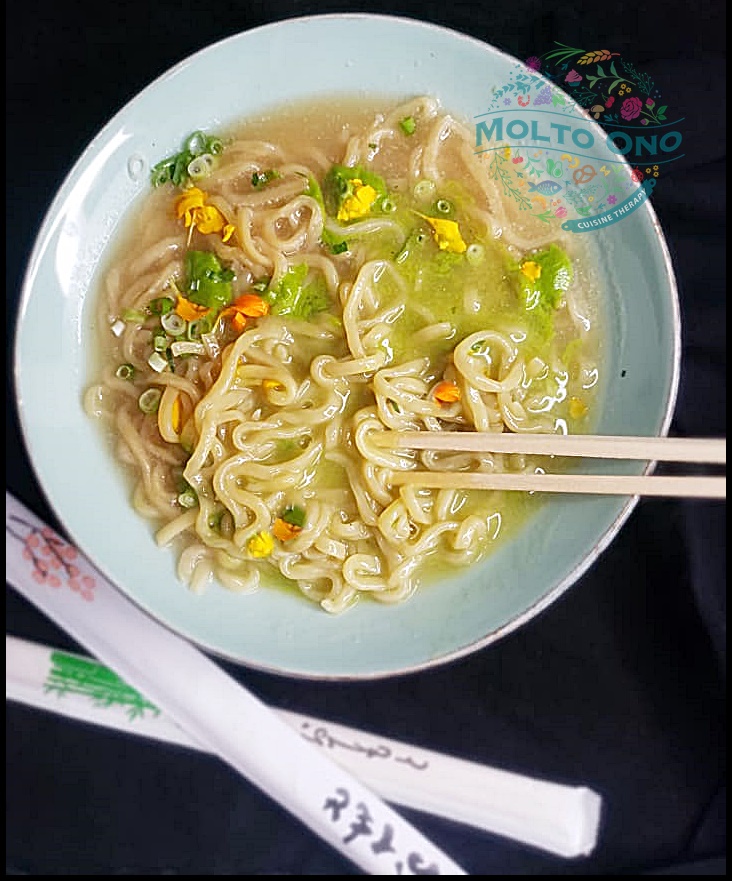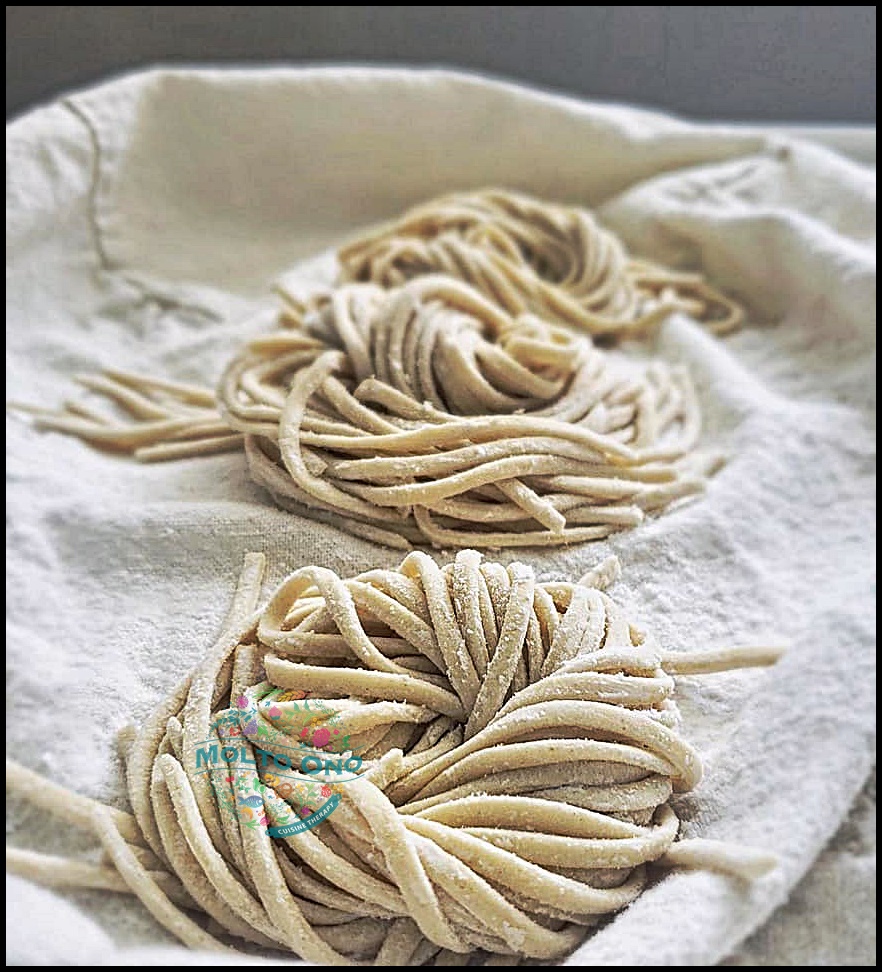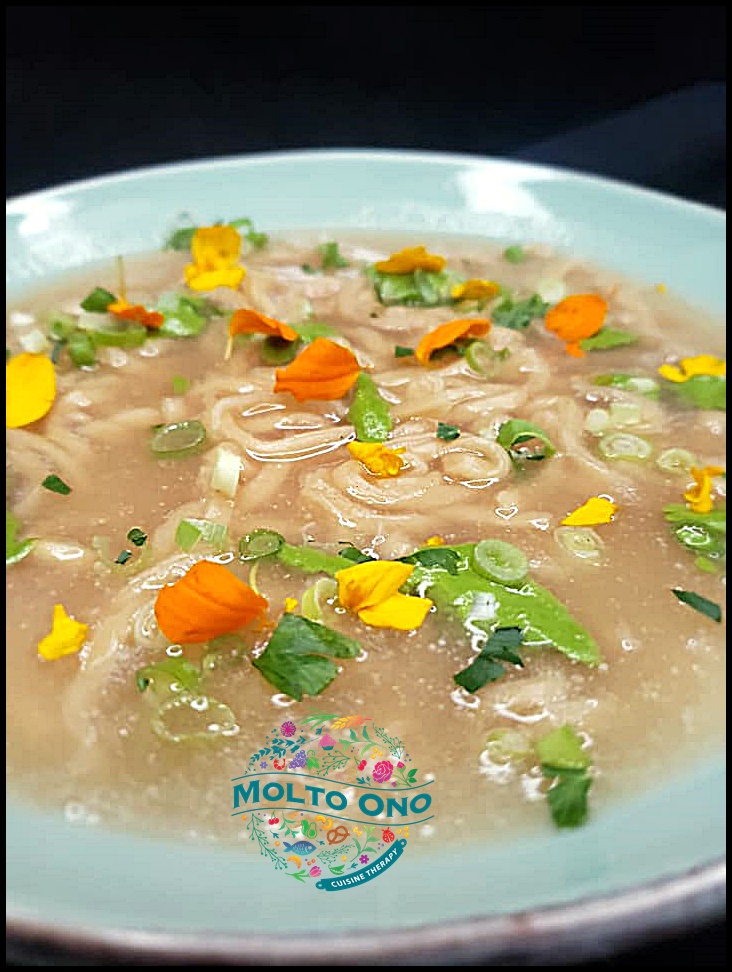What happens when an Italian makes Ramen noodles, Miso soup with Dashi? well…there must be some Pesto, too!
Seriously though, making Ramen noodles is so fascinating. Their deliciously slimy texture and the Umami of the Dashi with Miso gets brightened up by the Pesto. The result is a triumph of flavors. Not necessarily a quick thing to do, but worth every minute you will spend on it.
So, bring on a cold winter night, this soups is as comforting as it gets, without being too heavy.
The extra step needed to prepare the sodium carbonate is not really optional, but it super easy.
In conclusion, you will find this recipe a hodge-podge of measurements between grams, cups and ounces.
I know…however grams are important for the accuracy in making Ramen noodles, especially when counting such small quantities.
For the rest, cups and ounces are what we like, right?
Let’s do some Ramen now!

Video recipe of the day
- DifficultyDifficult
- CostExpensive
- Preparation time5 Hours
- Rest time1 Day
- Cooking time1 Minute
- Serving8
- Cooking methodStove
- CuisineItalian
Ingredients
Sodium Carbonate
Ramen Noodles
Cilantro pesto
Dashi broth with Miso
Most of the above mentioned ingredients can be found in any mainstream Asian grocery stores.
Tools
Steps
Steps are easy, just a lot of them! Also plan ahead: noodles need to rest overnight.
In addition you could make the dashi also the day before and have the full dish come together in no time.
These is a cheat sheet of the steps you will have to do:
1-make the sodium carbonate from sodium bicarbonate for the noodles
2-make and let rest the dough for the Ramen
3- prepare the pesto and let it cool
4- prepare the dashi
5-add the spices and make the Ramen broth
5-cook and serve
Not the usual 5 ingredients, 10 minutes Italian sauce, but this Miso dish will be worth your time.
Make the Ramen Noodles
To transform the Baking soda in something more alkaline bake the baking soda at 250 degrees for about 1 hour or until it will have reduced to 2/3.
I’m not really scientific about it, and usually 75 min will do . Collect the baked baking soda and DO NOT TOUCH it with your bare hands. Use a pan lined with foil to bake it, makes it easy to remove and collect.
Once you have done this, place all the ingredients for the noodles in the bowl of a stand up mixer and knead until the dough somewhat gathers around the hook . It is a low hydration dough, so don’t expect much.
Place it in a ziplock and refrigerate it for about 2 hours.
Divide the dough into 4 parts.
Roll out the dough with a rolling pin, until it fits the widest setting of the pasta machine.
Roll and fold on settings 1 and 2 to laminate the sheets, then roll them to setting nbr 4 of the Atlas Marcato.
Dust with potato or corn starch and let the sheets rest for 30 minutes before cutting.
Roll out to setting #6 of the pasta machine and cut with the spaghetti attachment or bigoli attachment like I did for a larger noodle.
Dust the Ramen with some potato starch and rest, covered in the fridge overnight for a firmer texture.

Make Dashi
Get the water in a large stockpot. You can double the quantity since the Dashi freezes well.
Brush gently the Kombu to make sure has no particles, do NOT wash it!! The white patina is the Umami.
Place the Kombu in water, and steep it for about 30 min. Do NOT let it boil, or becomes bitter.
Steep to extract all the flavor. Bring the water to almost a simmer, extract the Kombu and reserve for other uses (see below). Sprinkle the bonito flakes in the water and let them steep 10 minutes.
Meanwhile prepare a thin mash strainer, and when the time has passed, strain the broth from the flakes. Reserve the latter to make Furikake.
Make a slurry with some of the dashi and the Miso and return it to the pot.
This is called AWASE dashi with miso.
You can re heat it and add the ginger and lemongrass before adding the Ramen noodles later. See below.

Make the Cilantro pesto
This is the most easy of all steps: place all the ingredients minus the oil, in a Vitamix or high speed blender. Turn on low and add oil in a thin stream while blending. You will get a bright, flavorful smooth sauce.
This sauce can be used to toss the Ramen noodles too, without the broth! Yumm!
ItAsian Dish.

ASSEMBLE the dish
Bring the Dashi with Miso broth to a light simmer with the ginger and Lemongrass if desired.
Let it steep for a few minutes, then strain.
Meanwhile bring a large pot of water to a boil and add the Ramen noodles. Cook on low boil for about 2 to 3 minutes, or until desired texture and doneness. I like mine very “al dente” so about 2 minutes or less.
Transfer the noodle into the a bowl and top with broth. Garnish with dollops of Cilantro pesto and garnish with green onion or anything you like. Even Hardboiled eggs.
Serve at once.
NOTE: if you like you broth to be thick and almost creamy, cook the noodles directly into the Miso Dashi. The potato starch that is attached to the Ramen will naturally thicken the broth to a cream.
Enjoy!!

Varied doses for servings

